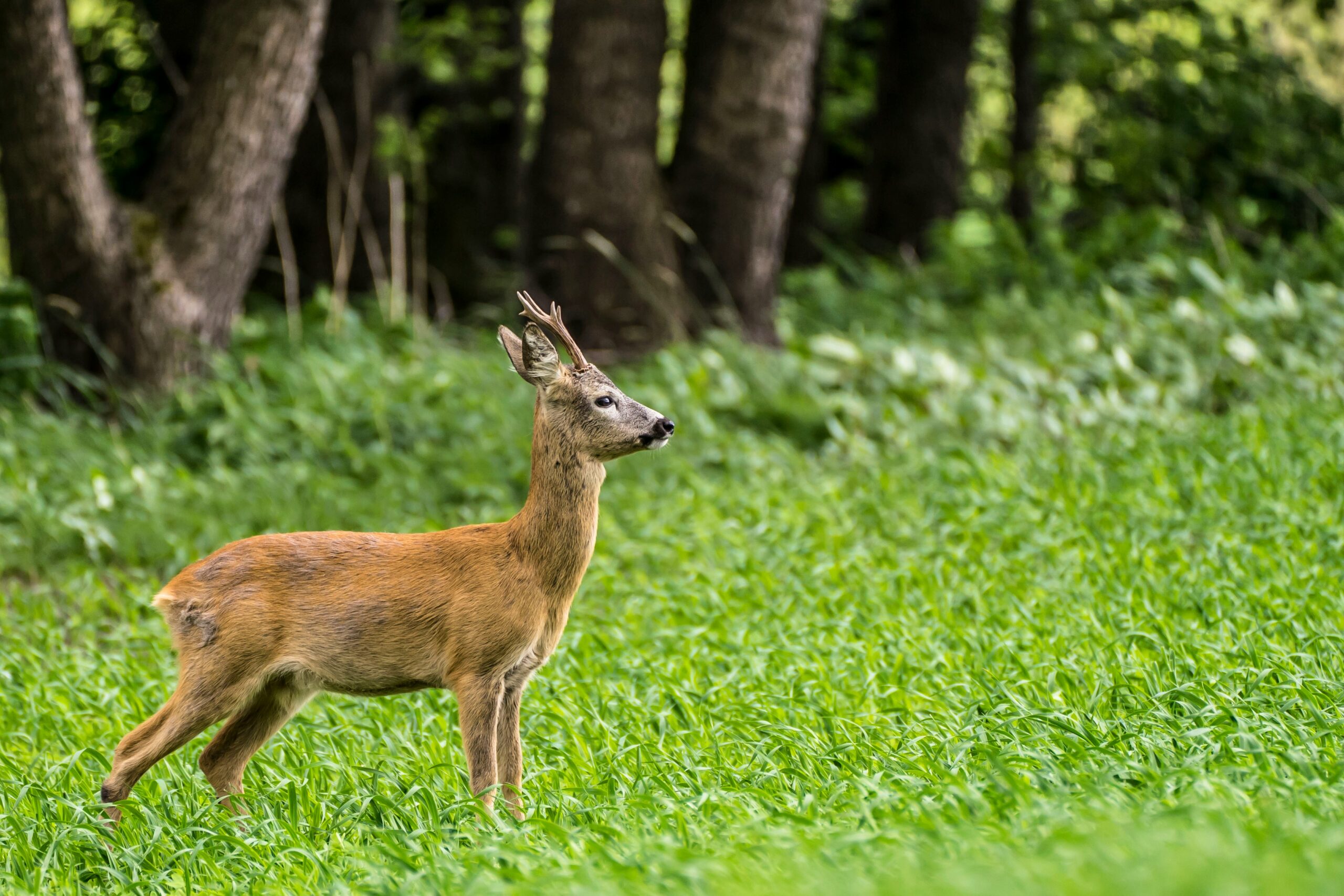Deer hunting is a big deal in the U.S., and it is about much more than just tracking down an animal. Hunting plays a key part in keeping nature in check, ensuring deer numbers continue to keep pace with what their environment can support. A manageable deer population helps maintain healthy habitats. It also benefits the local economy, bringing in money from license fees, gear sales, and visitors. But hunting is not just about making money or managing wildlife. It is also a tradition that ties communities together, passing down respect for nature and shared values from one generation to the next.
Preparation Tips
A successful hunt starts long before you hit the woods. It begins with making the right preparations, understanding your responsibilities as a hunter, and respecting nature and other hunters. Here is a quick list of what you are going to need for a successful deer hunt:
Essential Gear:
- Rifle or Bow: Select your tool, depending on your hunting style.
- Ammunition/Arrows: Stock up, considering practice and the hunt.
- Camouflage Clothing: Blend in with your surroundings.
- Hunting Boots: Navigate tough terrain and quiet approaches.
- Backpack: Carry your supplies and keep your hands free.
- Binoculars: Spot deer from a distance.
- Deer Calls: Attract deer closer to your location.
- First Aid Kit: Always be prepared for emergencies.
Permits Required:
- Hunting License: Check your state’s regulations for the specific type of hunting license you need.
- Deer Tags: Ensure you have the right tags for the deer you plan to hunt.
Safety Tips:
- Tell Someone Your Plan: Always let someone know where you are going and when you expect to return.
- Wear Hunter Orange: This makes you more visible to other hunters.
- Check Your Equipment: Before you head out, ensure all your gear is in good working order.
- Be Aware of Your Surroundings: Know what is next to your target before taking a shot.
- Understand the Weather: Prepare for changes in weather conditions.
12 Best States for Deer Hunting
1. Pennsylvania
Pennsylvania is deeply rooted in deer hunting tradition, boasting one of the nation’s largest white-tailed deer populations. This abundance offers hunters a chance to catch a decent buck. With over 4 million acres of public land available, hunters in Pennsylvania have the freedom to strategize their perfect hunt across various terrains, from thick forests to open travel routes.
- Deer Population: Over 1,450,000
- 2023-2024 Harvest: Over 430,010 deer harvested
- Public Land: Over 4.17 million acres of public land
- License Fees: $20.97 for residents; $101.97 for non-residents
- Season Timeline: October to February, details vary by zone and method
2. Missouri
Missouri has a diverse habitat, including forests, prairies, and fields, which makes it an excellent place for hunting top-end bucks. The state’s large deer population and diverse ecosystems offer hunters numerous opportunities. With access to over 2 million acres of public land, finding a hunting spot is easy, whether you prefer the view from a tree stand or a ground-level approach.
- Deer Population: Around 1,400,000
- 2023 Harvest: Over 326,448 deer were harvested
- Public Land: Over 2,525,000 acres of public hunting land
- License Fees: $20.50 for residents; $276.50 for non-residents
- Season Timeline: September to January, details vary by zone and method
3. Ohio
Ohio is a prime location for hunters aiming for trophy whitetail deer, boasting a substantial giant bucks population across more than half a million acres of public land. The “Buckeye State” presents a rich combination of farmlands and forests, setting the stage for a variety of hunting experiences.
- Deer Population: Over 725,000
- 2023 Harvest: A solid 210,973 deer were harvested
- Public Land: Over 651,000 acres of public land
- License Fees: $31.20 for residents; $76.96 for non-residents
- Season Timeline: September to February, details vary by zone and method
4. Arkansas
Arkansas is known for its white-tailed deer. In fact, it is the official state mammal. These deer are everywhere, thriving from the dense woods all the way down to the wetlands. Arkansas offers a ton of public lands to explore and set up your hunt, and there is a good mix of landscapes to keep things interesting.
- Deer Population: Around 900,000
- 2023 Harvest: Around 185,000 deer were harvested
- Public Land: Over 3.2 Million acres of public land
- License Fees: $25 for residents; $150 (One Day) for non-residents
- Season Timeline: October to February, details vary by zone and method
5. Wisconsin
Wisconsin is said to be the home of some of the biggest bucks in the country. The state’s massive white-tailed deer population makes it a prime location for hunters aiming for high volume and high-quality bucks. Spanning over 5 million acres, Wisconsin public lands range from the secluded northern woodlands to the agricultural boundaries in the south.
- Deer Population: Over 1,600,000
- 2023 Harvest: Over 173,942 deer were harvested
- Public Land: Over 5 million acres of public land
- License Fees: $24 for residents; $200 for non-residents
- Season Timeline: November to January, details vary by zone and method
6. Kansas
Kansas is great for deer hunting because of its open plains and woodlands. Here, mule deer and white-tailed deer are the main attraction. It is a good idea to step up your skills with blinds and decoys. These deer are savvy and have pretty much seen every trick in the book. While we are all waiting for the latest harvest data, the promise of almost half a million acres of public hunting land has whitetail hunters marking their calendars.
- Deer Population: Around 710,000
- 2023 Harvest: Stay tuned, numbers are due in May 2024.
- Public Land: More than 420,000 acres of public hunting land
- License Fees: $52.50 for residents; $477.50 for non-residents
- Season Timeline: November to December, details vary by zone and method
7. Kentucky
Kentucky is prime for white-tailed deer hunting, thanks to its extensive public lands and a significant deer population. The terrain varies widely, offering both challenges and opportunities for hunters of all levels. Kentucky encourages versatility in hunting methods due to its varied landscape. The success rate here is pretty high if you look at its yearly harvest data.
- Deer Population: Around 950,000
- 2023 Harvest: Around 144,493 deer were harvested
- Public Land: 802,000 acres of public land await
- License Fees: $35 for residents; $185 for non-residents
- Season Timeline: September to February, details vary by zone and method
8. Minnesota
Minnesota offers some of the highest buck harvest rates in the country. The state is focused on deer management, with particular attention to Chronic Wasting Disease (CWD) in some zones. With access to over 8 million acres of public land, hunters have ample space to choose their ideal hunting location. The state is home to some of the top-end bucks and offers excellent hunting conditions.
- Deer Population: Around 950,000
- 2023 Harvest: Over 158,678 deer were harvested
- Public Land: Over 8.2 million acres of public hunting land
- License Fees: $34 for residents; $185 for non-residents
- Season Timeline: September to December, details vary by zone and method
9. Oklahoma
Oklahoma stands out with its diverse landscapes, from grasslands to forests to mountains, making it an excellent location for hunting. The state primarily hosts white-tailed deer herds, though hunters might also encounter mule deer, particularly in the western regions. With access to almost one million acres of public land, finding a suitable hunting spot here is not a problem.
- Deer Population: Around 750,000
- 2022-2023 Harvest: Estimated 134,158 deer harvested
- Public Land: Over 932,000 acres of public hunting land
- License Fees: $20 for residents; $300 for non-residents
- Season Timeline: October to January, details vary by zone and method
10. Tennessee
Tennessee geography offers diverse deer hunting experiences, from the eastern mountains to the western plains. The state is a hotspot for white-tailed deer, known for their adaptability to different environments. Over 1.5 million acres of public land give hunters plenty of space to scout and settle into their preferred hunting methods.
- Deer Population: Around 900,000
- 2022-2023 Harvest: Around 163,154 deer were harvested
- Public Land: Over 1.5 million acres of public land
- License Fees: $33 for residents; $214 for non-residents
- Season Timeline: September to February, details vary by zone and method
11. Iowa
Iowa has that perfect mix of open fields and forest patches that white-tailed deer love. And there is plenty to go around. The state is welcoming to deer hunters looking to pursue impressive bucks. It has lots of managed public land to keep both the deer and hunters happy. Whether you are into ambushing mature bucks in natural funnels or prefer a more open-field approach, Iowa has you covered.
- Deer Population: Around 445,000
- 2023 Harvest: Nearly 104,000 deer were harvested
- Public Land: Over 266,000 acres of public land
- License Fees: $33 for residents; $348.50 for non-residents
- Season Timeline: October to January, details vary by zone and method
12. Illinois
In Illinois, it is the white-tailed deer that steal the show, particularly those trophy bucks that hunters dream about bagging. Thanks to the endless fields of corn and soy, deer have plenty to eat, which probably explains why they get so big here. There is a decent chunk of public land available, making it easier to find that perfect hunting spot. Stand hunting is the go-to here, so get ready to be patient.
- Deer Population: Around 660,000
- 2023 Harvest: Around 76,232 deer were harvested
- Public Land: About 698,000 acres of public land
- License Fees: $17 (Deer Archery) to $46.50 (Deer Muzzleloader Lottery Permit) for residents; $304 to $410 for non-residents.
- Season Timeline: October to January, details vary by zone and method
Hunting Strategies and Techniques
Best Practices
The key to a successful deer hunt lies in understanding deer behavior and utilizing effective tactics. Here are some fundamental practices to consider regardless of terrain or state:
- Read the Wind: Deer rely heavily on their sense of smell. Always hunt downwind of where you expect deer to appear. Pay attention to wind shifts and reposition yourself if necessary.
- Decoy Deception: Utilizing strategic decoys can be a great way to lure curious deer. Standing doe decoys can attract bucks during the breeding season, while fawn decoys might draw in protective does.
- Scent Control: Deer have an incredible sense of smell. Minimize human odor by wearing scent-eliminating clothing, washing with scent-free soap, and using strategic scent control products on your boots and equipment.
- Patience is key: Deer hunting often requires long periods of stillness and quiet observation. Patience is crucial, as impulsive movements can spook hesitant prey.
Advanced Techniques
- Rattling and Grunting: These vocalizations can mimic aggressive bucks during the breeding season, potentially drawing in dominant males to investigate the challenge. Use these techniques with caution and only during the appropriate season.
- Trail Camera Tactics: Strategically placed trail cameras are extremely useful tools for scouting deer activity patterns, identifying trophy bucks, and pinpointing hunting trails. Use them well in advance of the hunt to track deer movements on your hunting land.
After the Hunt: Processing and Conservation
Processing Your Deer
After you have harvested your deer, knowing how to handle it next is key. Let’s break it down simply:
- Field Dressing: First off, you must dress the deer in the field as soon as possible. This means removing its insides to prevent the meat from spoiling.
- Skinning and Cooling: Skin the deer carefully, preserving the hide if you want to keep it. Hang the carcass in a cool, shaded area to allow it to cool completely so it does not spoil.
- Butchering Options: Once you have your deer back home or to a processing spot, butchering is next. This is where you will break the deer down into manageable pieces, or cuts, that you can cook or freeze for later.
Conservation Efforts
When we talk about hunting, it is not just about heading into the woods hoping for a good day. There is a bigger picture here. Hunters, believe it or not, are some of the most passionate conservationists out there. Every time a hunter buys a license or a tag, they are chipping in to help keep our wildlife populations healthy and the whole ecosystem in check, so all kinds of wildlife can flourish.
Being a great hunter is more than just proving how well you can aim. It is about hunting ethically, knowing the rules, and respecting the land and the animals. By joining in on projects like wildlife habitat restoration or deer counts, hunters significantly contribute to conservation efforts. Passing down hunting traditions ensures the connection to nature remains strong for generations to come. So, in a way, hunters are guardians of the great outdoors, playing a crucial role in making sure our natural world remains rich and diverse. It is a pretty cool responsibility when you think about it.
REFERENCES:
- Deep Population By State Report -World Population Review
- Total Public Hunting Land Acres Available by State for USFS, BLM & State Owned Lands -Backcountry Chronicles
- 2022-23 Deer Harvest Report – AGFC
- Hunting Permit Cost Arkansas – AGFC
- Deer Harvested during the 2023 Hunting Season – Illinois Department of Natural Resources
- Illinois Hunting License—DNR Illinois
- Iowa DNR shares hunting and trapping results from 2023
- License Cost—Iowa Department of Natural Resources
- Kansas Hunting License—Kansas Department of Wildlife & Parks
- 2022-2023 Kentucky White-Tailed Deer Harvest Report
- License and Permit Descriptions—Kentucky Department of Fish & Wildlife
- Minnesota DNR announces 2023 deer season harvest results
- Hunting licenses—Minnesota DNR
- Deer Harvest Summary 2022-2023—Missouri Department of Conservation
- Deer: Permits | Missouri Department of Conservation
- Ohio’s Final 2023-24 Deer Harvest Report
- Buy Hunting Licenses and Permits—Ohio Department of Natural Resources
- 2022-2023 Big Game Harvest Report—Oklahoma Department of Wildlife Conservation
- License Fees—Oklahoma Department of Wildlife Conservation
- GAME COMMISSION RELEASES DEER HARVEST ESTIMATES—Pennsylvania Pressroom
- License Types—PA Game Commission
- TN 2024 Deer Harvest
- License and Permit Information: Tennessee Wildlife Resource Agency
- 2023 Gun Deer Hunt License Sales And Harvest Totals—DNR Wisconsin
- Resident licenses—Wisconsin DNR


